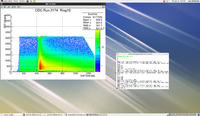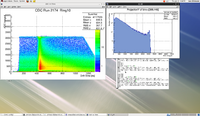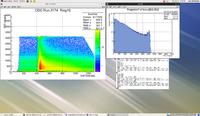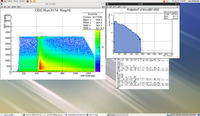Difference between revisions of "Minutes-1-8-2015"
m (Text replacement - "/halldweb1.jlab.org/" to "/halldweb.jlab.org/") |
|||
| (5 intermediate revisions by 2 users not shown) | |||
| Line 1: | Line 1: | ||
| − | + | January 8, 2015 FDC+CDC meeting | |
= Connection = | = Connection = | ||
| − | # [https:// | + | # [https://halldweb.jlab.org/wiki/index.php/Connect_to_Bluejeans_Meetings Instructions for Bluejeans meeting connection] |
# FDC meeting ID: 290664653 | # FDC meeting ID: 290664653 | ||
# To join via a Web Browser, go to the page [https://bluejeans.com/290664653] https://bluejeans.com/290664653. | # To join via a Web Browser, go to the page [https://bluejeans.com/290664653] https://bluejeans.com/290664653. | ||
| Line 22: | Line 22: | ||
# Engineering | # Engineering | ||
# Other | # Other | ||
| − | |||
| − | |||
| − | |||
= Minutes = | = Minutes = | ||
| − | Participants: Naomi (CMU), Eugene, Mike, Dave, Fernando, Chris, Nick, Simon, Beni, Vlad, Sergey, and Lubomir (JLab). | + | Participants: Naomi (CMU), Eugene, Mike, Dave, Fernando, Chris, Nick, Simon, Cody, Beni, Vlad, Sergey, and Lubomir (JLab). |
== CDC update == | == CDC update == | ||
| Line 42: | Line 39: | ||
- Lubomir found the drift velocity of the FDC in the Hall is higher than it was in the EEL126: see the time-to-distance functions plotted above. If it was only Ar/CO2 this suggests that we have now approx. 46/54 gas mixture instead of 40/60 in the EEL, as estimated with Garfield simulations. If this is the case this may partially explain the higher signals seen in the CDC, but certainly not enough to explain the factor of 4 change. It is not clear how one can get 54% CO2 instead of 60%. The gas factor "uncertainty" found by Mike (0.773 actual instead of 0.74 according to the tables) results in 58.5%CO2. At the same time the drift velocity change might be due to adding of alcohol to the gas mixture, which has to be studied with Garfield. | - Lubomir found the drift velocity of the FDC in the Hall is higher than it was in the EEL126: see the time-to-distance functions plotted above. If it was only Ar/CO2 this suggests that we have now approx. 46/54 gas mixture instead of 40/60 in the EEL, as estimated with Garfield simulations. If this is the case this may partially explain the higher signals seen in the CDC, but certainly not enough to explain the factor of 4 change. It is not clear how one can get 54% CO2 instead of 60%. The gas factor "uncertainty" found by Mike (0.773 actual instead of 0.74 according to the tables) results in 58.5%CO2. At the same time the drift velocity change might be due to adding of alcohol to the gas mixture, which has to be studied with Garfield. | ||
| − | - Vlad showed | + | - Vlad showed latest results from gain calibration studies. There's some systematics for the "bad" channels with gain coefficients >3, but the normal channels are stable. Vlad has a list of 8 channels showing no signal at all in the fADC125, that are to be studied with the Mike's tool. Vlad will have soon the first table with the gains to be implemented by Simon in the standard code. |
== Electronics == | == Electronics == | ||
| − | - | + | - Nick and Chris started re-routing the CDC HV cables, they will be attached to 4 thin bars (as a frame) mounted in front of the detector. Additional capacitor will be put on the HVBs to further reduce the noise. Mike asked but Fernando said there's no need to re-route also the LV cables, they have constant consumption (diff. amplifiers). |
| + | |||
| + | - Fernando ordered HV connectors that are needed to built the filter for the CAEN HV. CAEN are interested in this and they have already built such a box in a VME module frame (for one HV cable). We will get one of this for testing. CAEN are interested also in building the final filter-boxes, no discussions yet if they want to charge us for this. | ||
| − | - | + | - Cody: the new 25 fADC125 are here and are being tested, very good results so far. We discussed also the issues with the f125 firmware, but this will be left for the fADC125 meeting. |
== Engineering == | == Engineering == | ||
| Line 54: | Line 53: | ||
- The FDC chiller is ready for shipping (or has been shipped), expect it back in 6-7 weeks. | - The FDC chiller is ready for shipping (or has been shipped), expect it back in 6-7 weeks. | ||
| − | - We discussed options for turning off the power of the FDC chiller in case the temperature of the Fluorinert is out of the limits. On the next day Dave looked into this and decided | + | - We discussed options for turning off the power of the FDC chiller in case the temperature of the Fluorinert is out of the limits. On the next day Dave looked into this and decided to do something he's doing for HallB: external box that is plugged between the outlet and the chiller (note: 208V three phases 30A). It has a relay inside controlled by the PLC system that is taking the temperature from the epics readings of the chiller. |
== Other == | == Other == | ||
- Eugene expects from the drift chamber groups results on: efficiency, alignment, resolution, by the end of the month. | - Eugene expects from the drift chamber groups results on: efficiency, alignment, resolution, by the end of the month. | ||
Latest revision as of 00:26, 1 April 2015
January 8, 2015 FDC+CDC meeting
Contents
Connection
- Instructions for Bluejeans meeting connection
- FDC meeting ID: 290664653
- To join via a Web Browser, go to the page [1] https://bluejeans.com/290664653.
Agenda
- CDC update (Mike)
- FDC update gas difference, gain calibration(Lubomir, Vlad)
- Electronics
- Engineering
- Other
Minutes
Participants: Naomi (CMU), Eugene, Mike, Dave, Fernando, Chris, Nick, Simon, Cody, Beni, Vlad, Sergey, and Lubomir (JLab).
CDC update
- Beni showed a plot, charge integral vs drift time, and slices of it, integral distribution for different drift times (plots attached). For smaller drift times you see the pedestal and the peak well separated and the amplitudes going down exponentially. For big drift times one starts seeing a second bump (not clear why!), while the first peak gets closer to the pedestal (because the track length inside the straw gets shorter)
- Mike was working on a tool to view the signals from the fADC125 modules in a single crate using the built-in pulser. Mike is also working on the CDC efficiency, it's >90% if require the track to be at <1mm to the wire.
- Naomi has the test set-up at CMU working again with the prototype straws and old electronics. Waiting for Fernando to get the up-to-date pre-amps/firmware in order to compare with the results in the Hall.
FDC update
- Lubomir found the drift velocity of the FDC in the Hall is higher than it was in the EEL126: see the time-to-distance functions plotted above. If it was only Ar/CO2 this suggests that we have now approx. 46/54 gas mixture instead of 40/60 in the EEL, as estimated with Garfield simulations. If this is the case this may partially explain the higher signals seen in the CDC, but certainly not enough to explain the factor of 4 change. It is not clear how one can get 54% CO2 instead of 60%. The gas factor "uncertainty" found by Mike (0.773 actual instead of 0.74 according to the tables) results in 58.5%CO2. At the same time the drift velocity change might be due to adding of alcohol to the gas mixture, which has to be studied with Garfield.
- Vlad showed latest results from gain calibration studies. There's some systematics for the "bad" channels with gain coefficients >3, but the normal channels are stable. Vlad has a list of 8 channels showing no signal at all in the fADC125, that are to be studied with the Mike's tool. Vlad will have soon the first table with the gains to be implemented by Simon in the standard code.
Electronics
- Nick and Chris started re-routing the CDC HV cables, they will be attached to 4 thin bars (as a frame) mounted in front of the detector. Additional capacitor will be put on the HVBs to further reduce the noise. Mike asked but Fernando said there's no need to re-route also the LV cables, they have constant consumption (diff. amplifiers).
- Fernando ordered HV connectors that are needed to built the filter for the CAEN HV. CAEN are interested in this and they have already built such a box in a VME module frame (for one HV cable). We will get one of this for testing. CAEN are interested also in building the final filter-boxes, no discussions yet if they want to charge us for this.
- Cody: the new 25 fADC125 are here and are being tested, very good results so far. We discussed also the issues with the f125 firmware, but this will be left for the fADC125 meeting.
Engineering
- The FDC chiller is ready for shipping (or has been shipped), expect it back in 6-7 weeks.
- We discussed options for turning off the power of the FDC chiller in case the temperature of the Fluorinert is out of the limits. On the next day Dave looked into this and decided to do something he's doing for HallB: external box that is plugged between the outlet and the chiller (note: 208V three phases 30A). It has a relay inside controlled by the PLC system that is taking the temperature from the epics readings of the chiller.
Other
- Eugene expects from the drift chamber groups results on: efficiency, alignment, resolution, by the end of the month.





